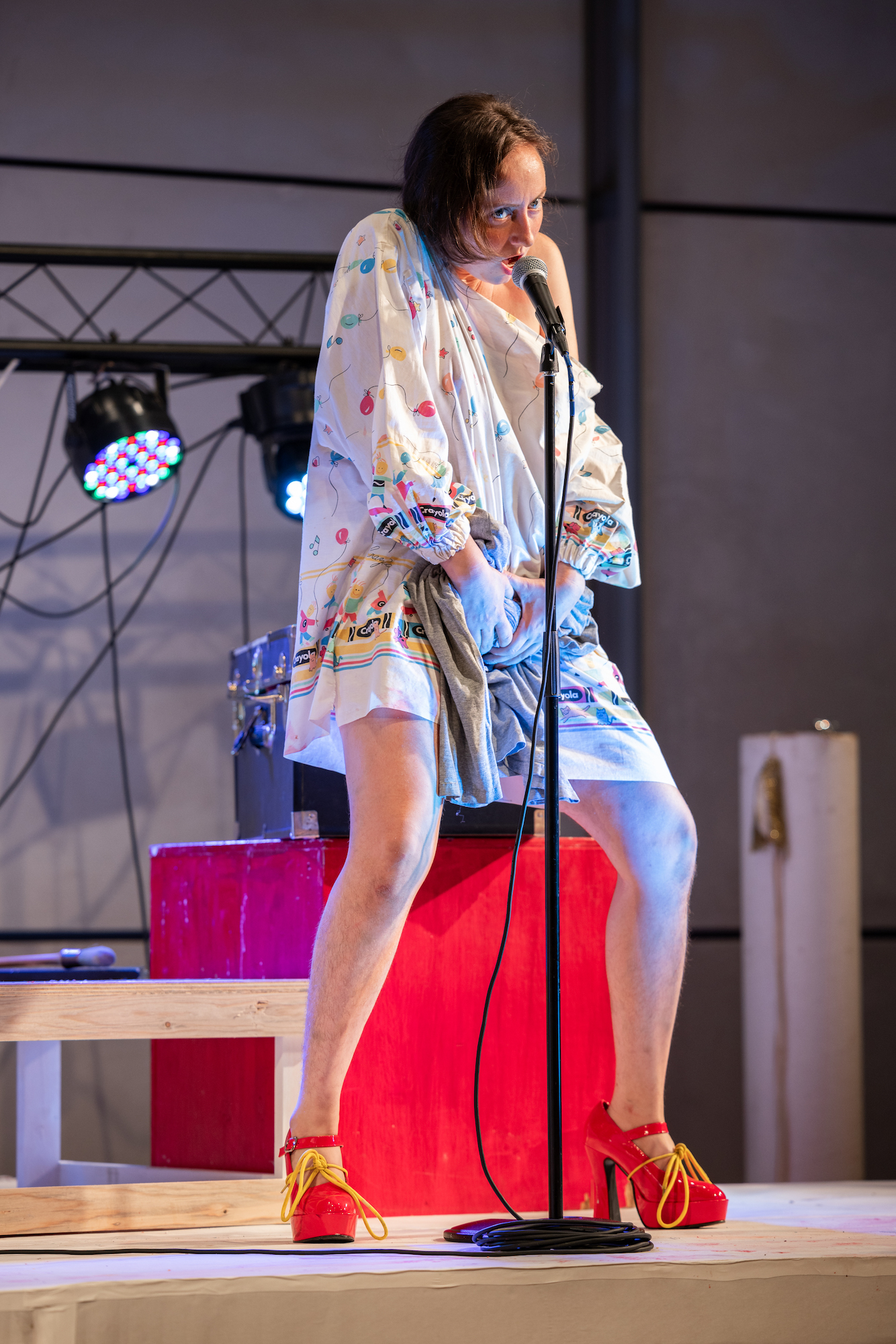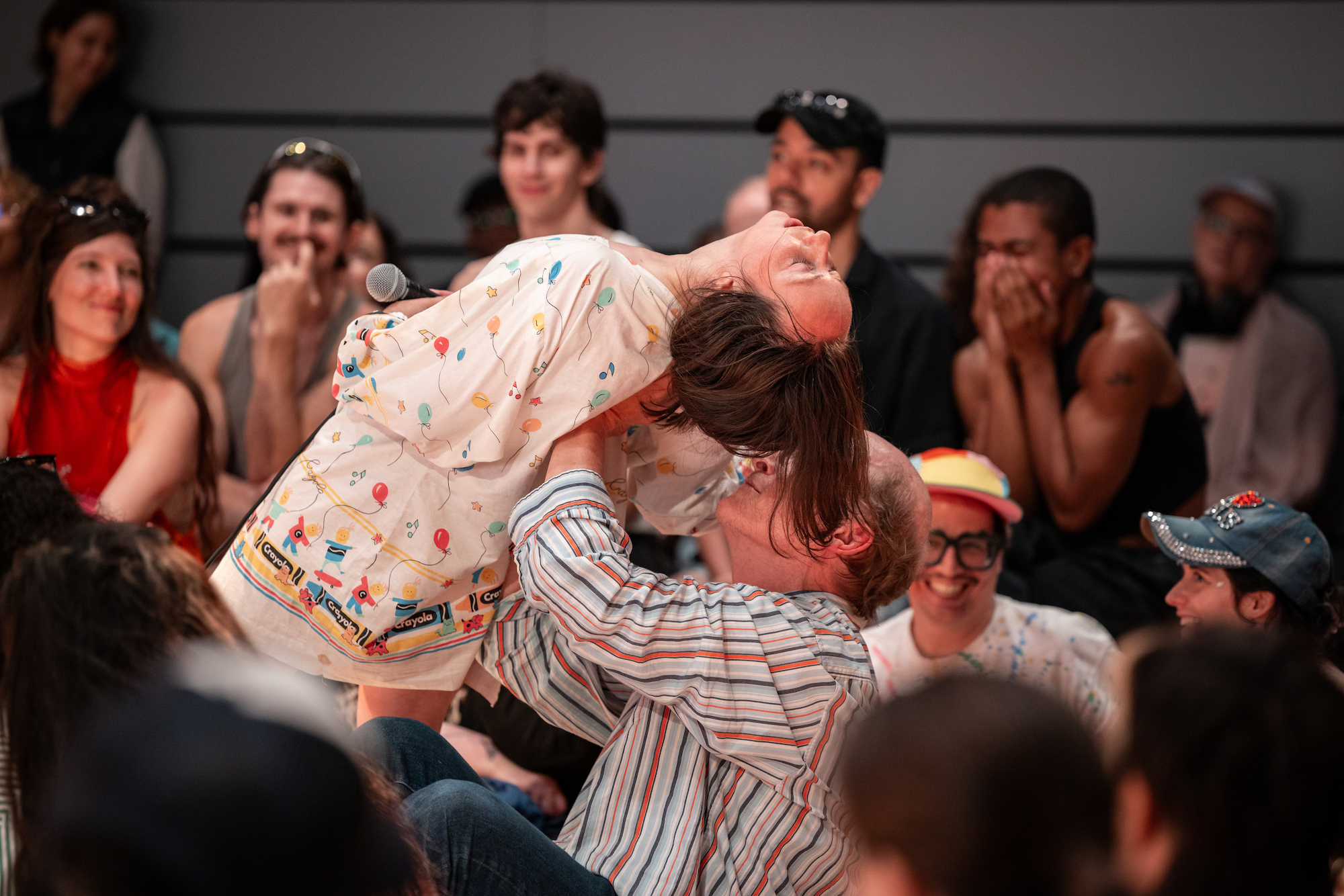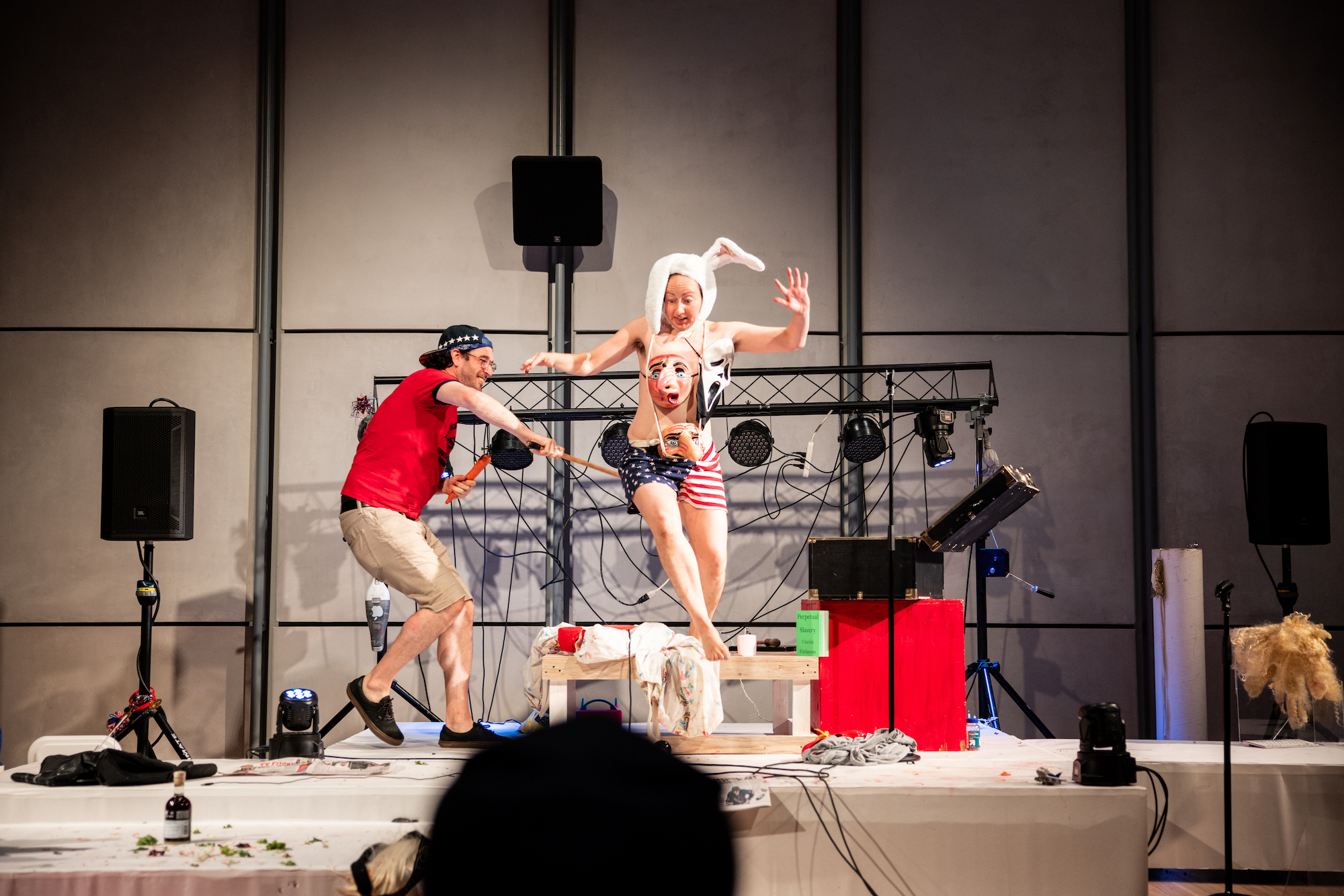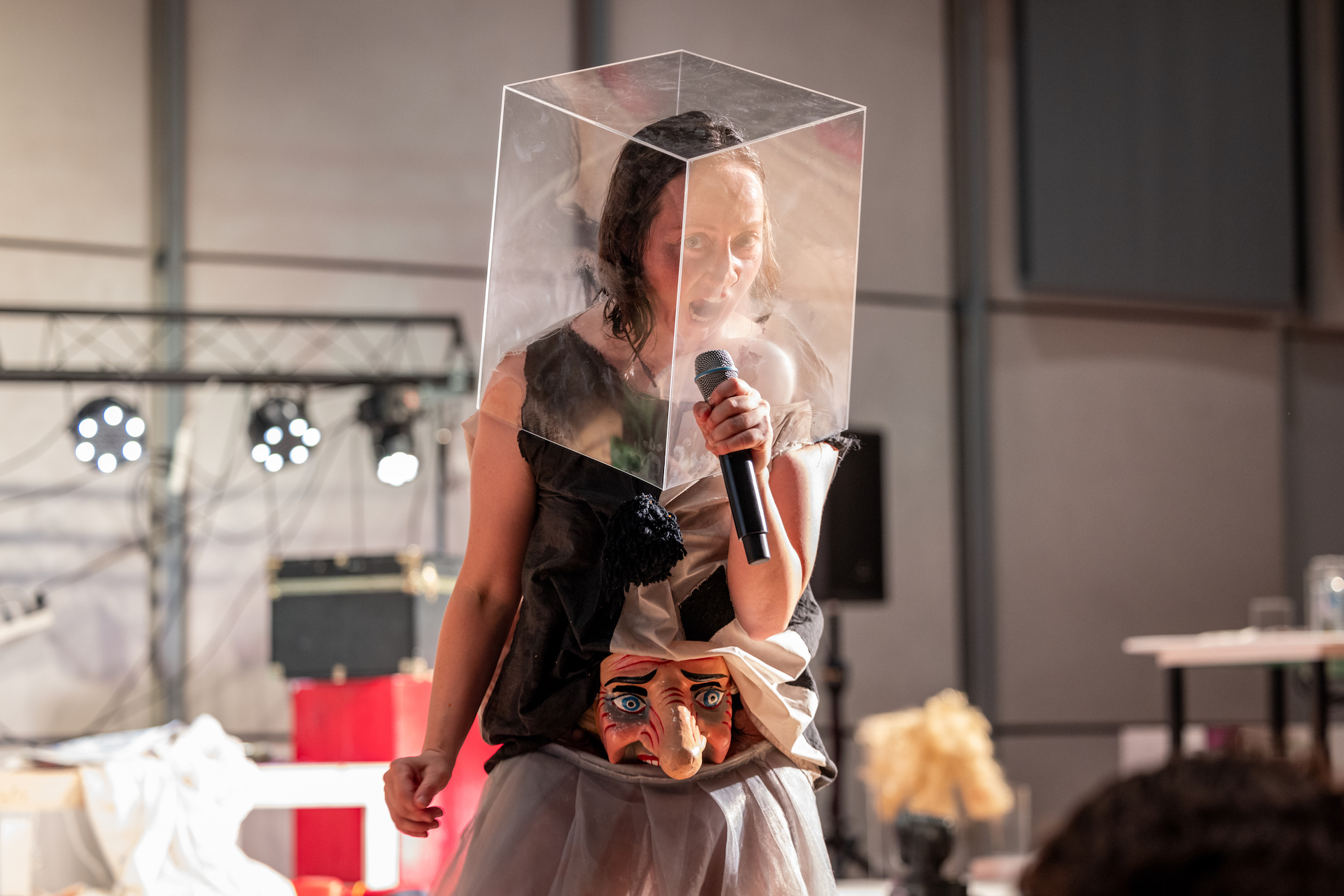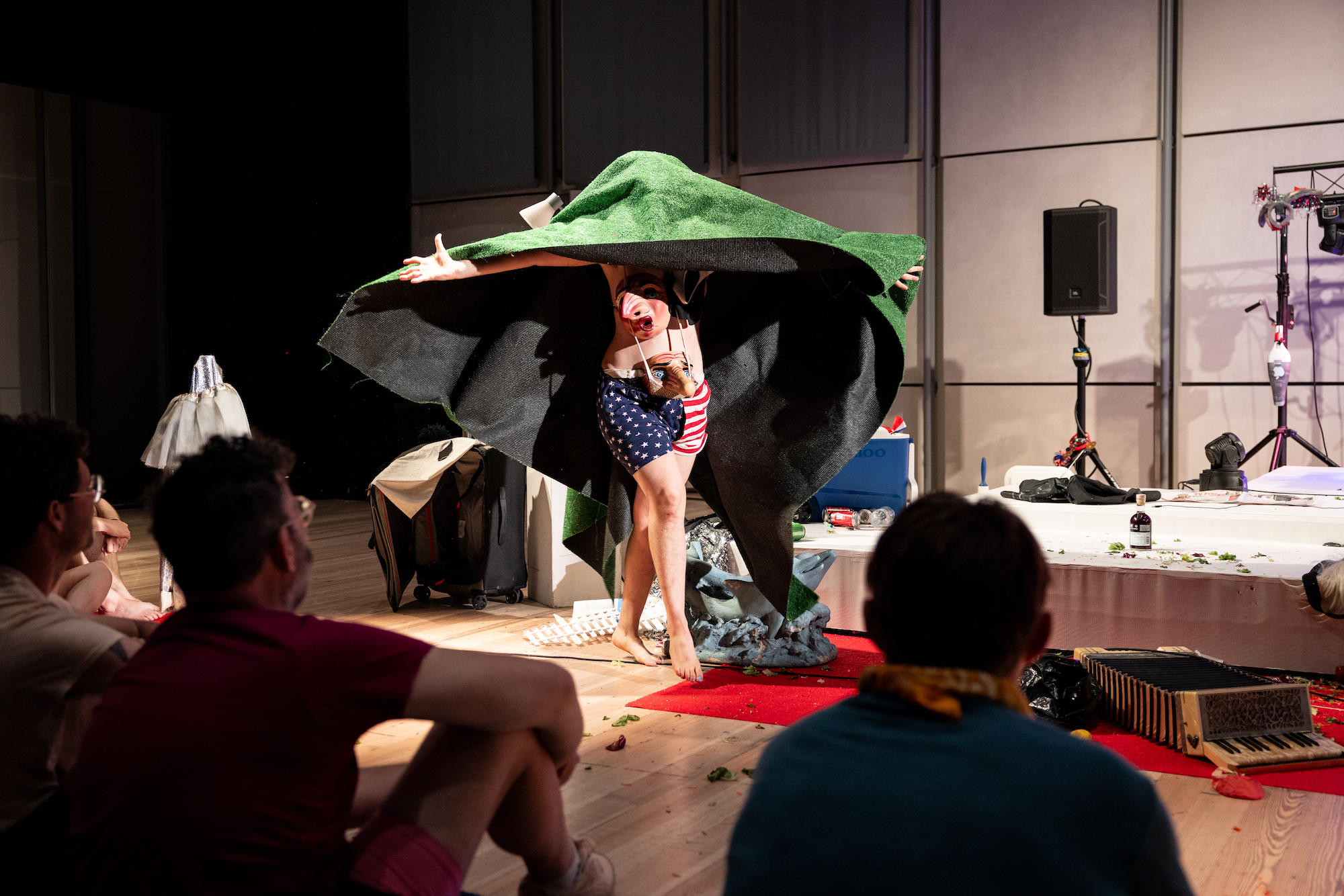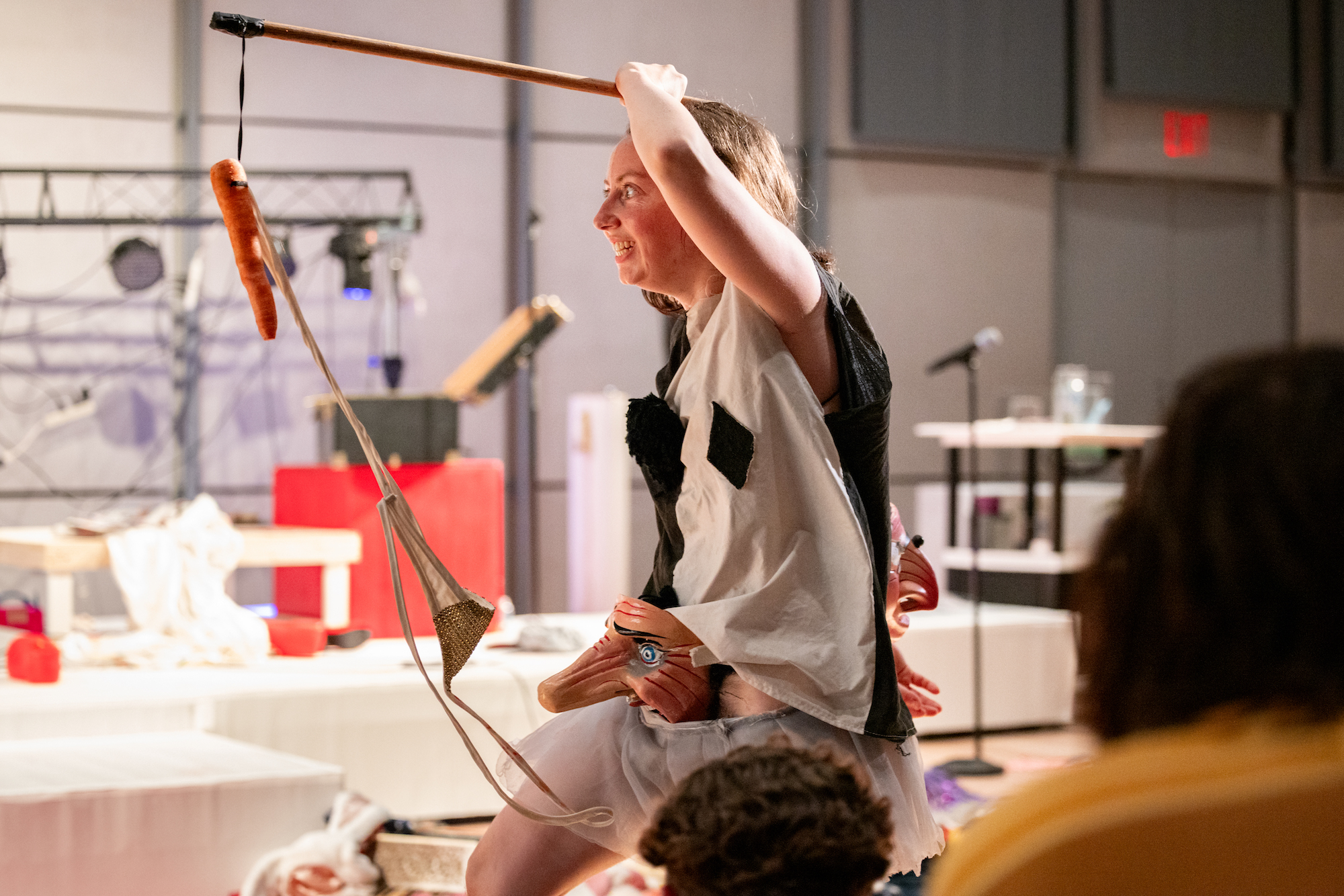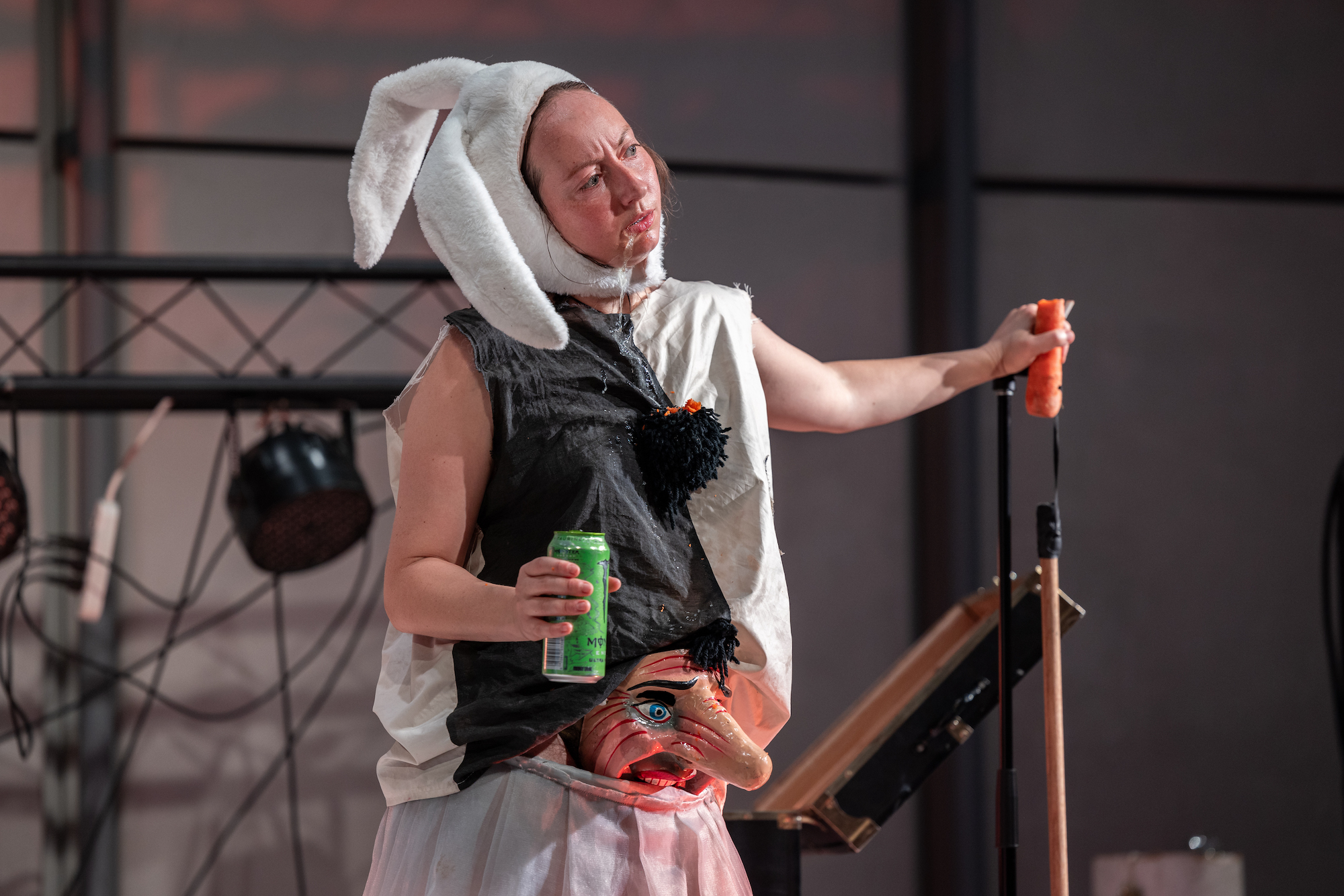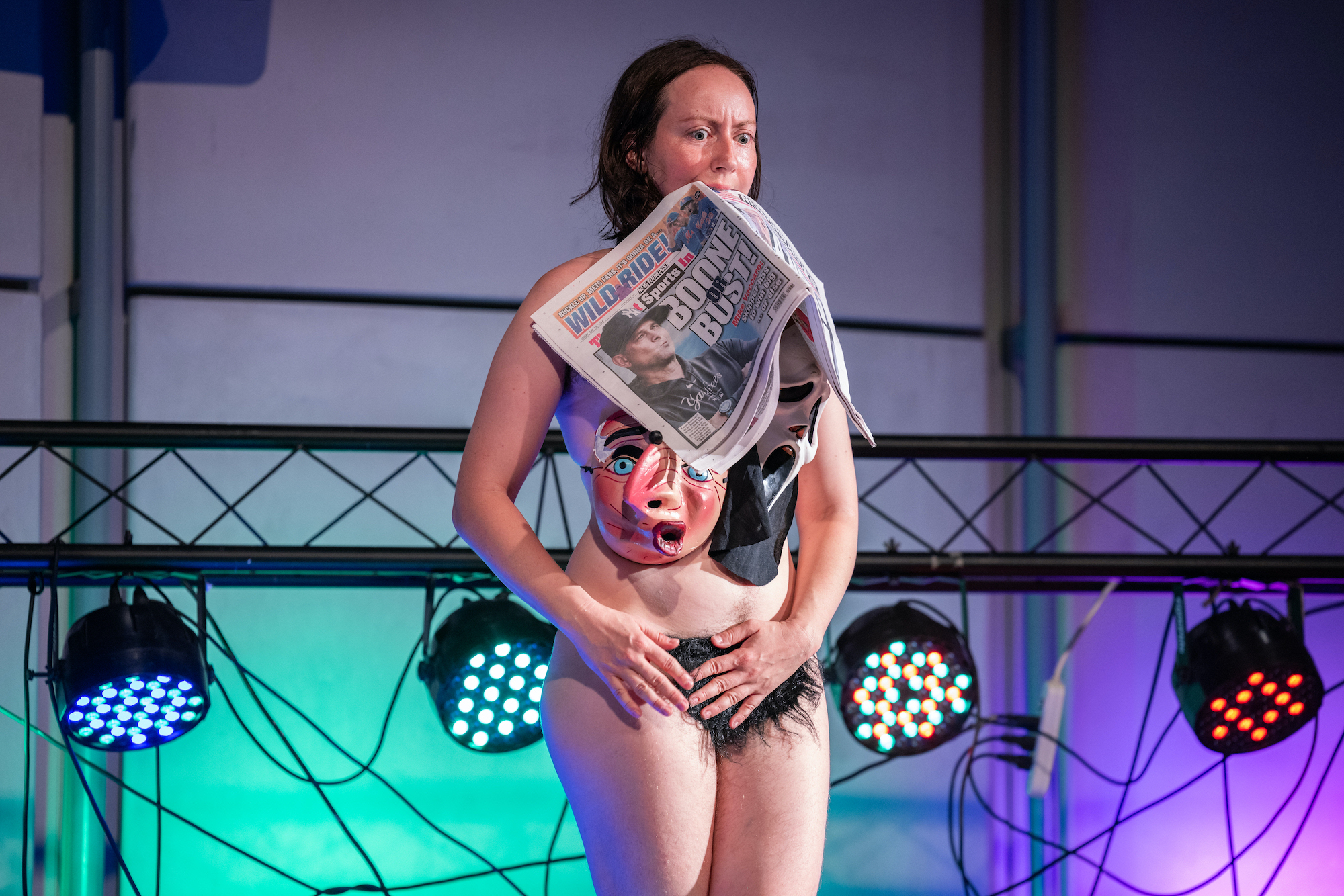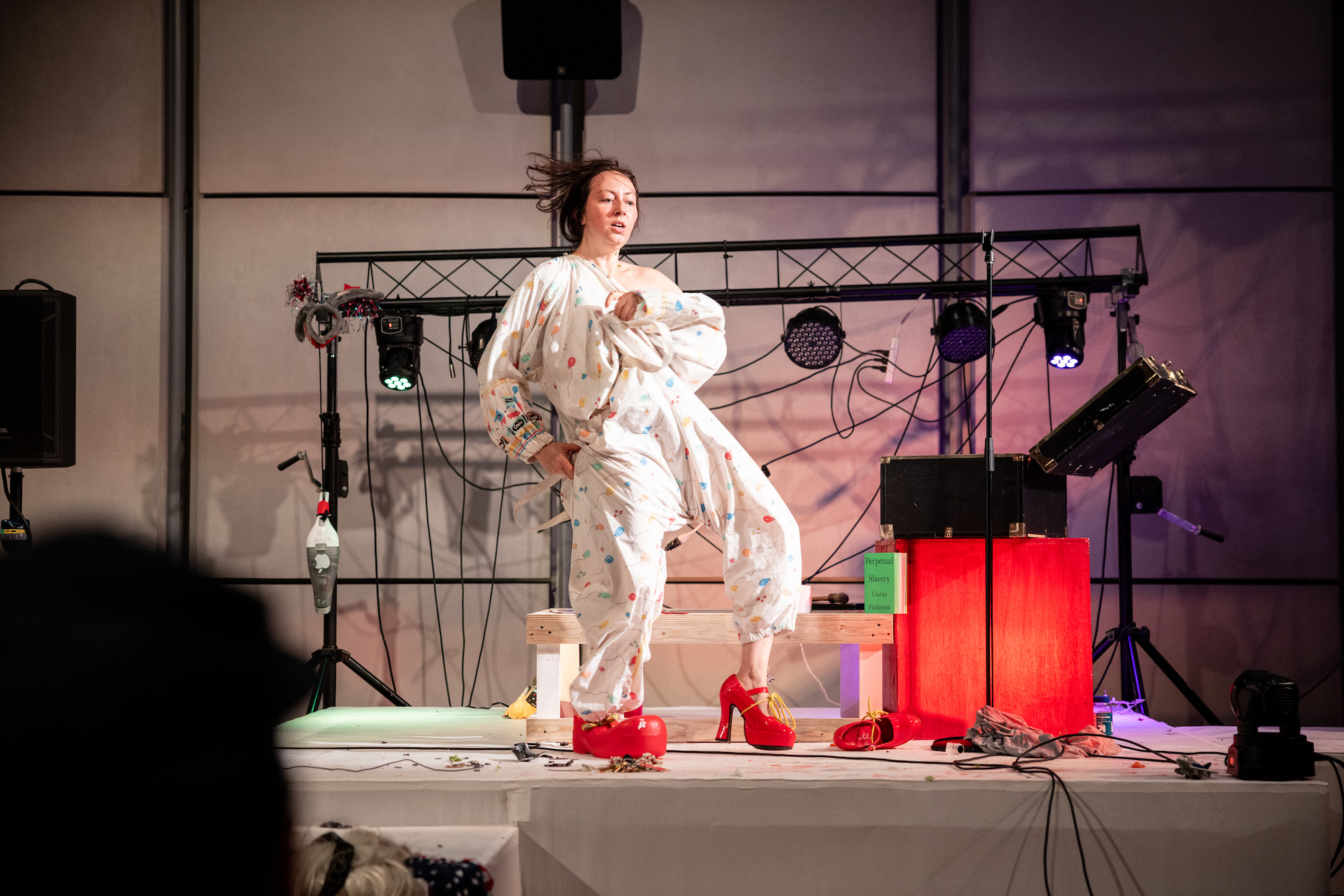
Alex Tatarsky, MATERIAL, 2024 [photo: Maria Baranova, courtesy the artist, Whitney Museum, NYC]
Alex Tatarsky: Power|Play
Share:
New York and Philadelphia–based artist Alex Tatarsky’s practice operates somewhere between the serious and the sardonic. Drawing upon histories of performance art, theater, vaudeville, and dadaism, their satisfying level of disciplinary ambiguity translates into a particular brand of metahumor. Tatarsky’s work often centers the figure of the clown—the bouffon, the jester, the classic archetype that at once embodies and rejects seemingly seedy aspects of the human condition, ranging from shame to lust, complacency to failure.
We met over Zoom—coincidentally fewer than ten blocks from each other in Queens, New York—to discuss some of their performances, including MATERIAL, a durational exploration of the physical dimensions of performance, mediated through a series of props, audience interactions, and tongue-in-cheek instigations; and Sad Boys in Harpy Land, a semi-autobiographical act that mirrors Goethe’s Wilhelm Meister’s Apprenticeship—the story of an 18th-century theater kid’s journey of self-discovery. As with many of our conversations over the years, we reflect on how elements of narrative, prop, space, and time afford critiques of soft power, as negotiated through the comedic gesture. We also consider the limitations of that critique when the conditions enabling such power become increasingly self-referential and absolute.
Re’al Christian: Let’s see if talking about comedy kills it.
Alex Tatarsky: It definitely will, but that’s okay. We can commit to the seriousness of the topic.
RC: In your performance, you often make these statements that are very profound, but you deliver them in the most absurd way. One of them, MATERIAL (2024), includes the line “Every time I go to the museum, I hope to learn something, but I come out and I’m exactly the same.” And the way you delivered it so perfectly, I assumed it was a quote from something, but when I Googled it, the AI said, “That’s a fantastic sentiment. Museums are incredibly educational places.
AT: AI is not to be trusted, as we know. It’s funny hearing that line echoed back to me, because that particular series of shows, MATERIAL, was largely improvised. So, I was in some kind of fugue state, which maybe is why it seemed like a thing someone else had said, because, perhaps, it was not me. Although it is something I’ve been chewing on a lot—the perception that art is edifying. Because I was performing that show in an art museum, I was thinking about the expectation that the art museum teach us something. But now, since I’m preparing for a bunch of shows in a theater context, I’m thinking about the didactic vibe of theater or the expectation that narrative is there to show us how we are as humans and thus show us how to be better as humans. And I’m finding that I’m having a kind of allergic reaction to that, at the moment.
RC: There’s a part in the performance where you talk about the peculiarities of performing or experiencing a performance in a museum where the viewer is kind of conditioned to walk right up to the line—I think is how you phrase it—and sort of stand and look and try their best to absorb and discern meaning and information. But that process is inherently one of looking and not laughing, where there’s a very clear line, both literal and psychological, between the artwork and the audience. I’m interested in the context in which your work is seen—whether it’s in the museum, the theater, the comedy club, the bar, and how these different contexts might factor into our response to the work.
AT: Context feels really important, annoyingly so, because I am somewhat lazy—proudly and profoundly lazy—and I wish I could just come up with something and … keep performing it again and again. But every single evening is a different evening, and every crowd is a different crowd, and every venue is a different venue with its own particular history and lineage and set of rules and expectations. So, it’s like an ongoing study in how these spaces teach crowds to be, which, again, brings up the notion of discipline, because we’re disciplined into certain codes of behavior. I definitely find it most fun to perform in bars and comedy clubs and underground music venues—places that have a permissiveness, where audiences can be loud and raucous and rowdy, are guided by the context to let their feelings become audible.
Alex Tatarsky, MATERIAL, 2024 [photo: Walter Wlodarczyk, courtesy the artist, Whitney Museum, NYC]
Conversely, there are spaces where you can feel that the crowd has been disciplined to conceal their feelings and to behave in a “proper” way. I feel the disciplining of the body strongly in certain institutional art spaces. You have to crack that open first. In comedy or DIY venues, that sense of cracking open has begun before you get on stage. So, a lot of the work has already been done, because people are lubricated by intoxication and noise and proximity and intimacy and perhaps filth. I’m thinking about a show I did a few weeks ago, where the audience was so rowdy, to the point where a fight almost broke out in the crowd because this one puppeteer was going on too long. So, by the time I got on stage, I was already so delighted. I was, like, “Okay, this is an out-of-control audience, but they’re invested.” And so, it’s really a delight to get to play with them and play with the line between us, because they’re already interested in troubling that line and troubling the power dynamic. Like, well, maybe the performer actually doesn’t have the power. The audience can so quickly remember that they are a crowd, and they’re more powerful, and can depose the performer if they so wish.
RC: [laughs] I feel like I need more context, but I also want to linger on this idea of the ways that we’re conditioned within spaces. You’ve said that the performance happens within the room, and that your kind of engagement with the audience is what the performance is.
AT: This particular performance was part of something called Idiot’s Hour that’s organized by Matthew Silver, who is an interesting person to think about in relation to humor and absurdity. I grew up seeing him perform on the street, usually in Washington Square Park or by the Cube at Astor Place in a Speedo, farting a lot, and squawking a rubber chicken. What made it really wild and special was that it wasn’t totally clear if it was a performance.
I started performing, in part, because I was watching him one day, decades ago, and he was, like, “Do you perform? You should perform at this thing I’m doing.” And so, I started performing at these events he would organize in Bushwick bars. I remember one time I got booed off the stage for going over my time. This was really early on in my performing-around-town career, but it obviously left an impression. That time on stage is not yours. That attention does not belong to you. It’s your job to cultivate focus. You’re an energy worker.
RC: In performances you’ve done, it’s interesting seeing you goad the audience into participating in the performance, into reacting and experiencing that discomfort or anxiety or dislocation with you. I’m thinking about the Whitney Biennial performance, MATERIAL, and at one point you use actor and performer Jim Fletcher as a chair.
AT: Jim is so great. What a generous man and community member. It’s so funny because the first time I met Jim, I was performing at Judson as part of Movement Research, doing an excerpt that would become my show Sad Boys in Harpy Land. And I knew I wanted to bring up a classically straight white male onto the stage at some point and have them hold up this double-sided mirror I have, so that they would be looking at themselves in the mirror and I would be looking at myself in the mirror, and we’d kind of be looking at each other, but we’d really be looking at ourselves. And so, I planted the DSM, this huge, thick, psychiatric manual, under the chair of someone who fit that description, straight white male—because I feel like it’s always fun to humiliate the person who holds some kind of power in the room by virtue of their identity and accompanying privileges. And so … I hid the DSM under the chair of this guy, who everyone thought was a plant, because this is a downtown performance audience, and everyone in the room knew Jim Fletcher was a legend except me. And he was perfect. He was the perfect mark… my perfect prop.
Alex Tatarsky, MATERIAL, 2024 [photo: Walter Wlodarczyk, courtesy the artist, Whitney Museum, NYC]
RC: He does the kind of affected straight white male persona so well. I’m thinking about his work with New Red Order, especially.
AT: I think he’s excited to sub from within this position of power, or to actively seek out a kind of role reversal.
RC: Going back to the way you’re using material in your work, as both a concept and structure, you utilize props, often emerging from unexpected places—on the stage, on your body—and you also respond to the physical elements in the room, and to people, in what sometimes feels like free association, but other times kind of vacillates between scripted and nonscripted language and movement. Could you talk about the materiality of your performance and how that informs other immaterial dimensions of it?
Alex Tatarsky, MATERIAL, 2024 [photo: Maria Baranova, courtesy the artist, Whitney Museum, NYC]
AT: Well, in thinking about MATERIAL as a score or frame for improvisation, I was thinking a lot about the hauntedness of objects in the context of the museum, which has such a history of stealing sacred objects—in particular, the Western art museum stealing and displaying items from non-Western cultures. Although, of course, I think one of my interests is in deconstructing the fiction of “the West” itself as a kind of story that started being told not that long ago. But nonetheless, yeah, objects feel really haunted in the museum. I became interested in how art museums consider something art, an art object, when it’s taken out of its context. That’s kind of what makes it art, that it’s not being used in some other way in a social context. And I find that both intriguing and depressing, because I want art to do something in the world. I don’t want something to be valued as art because it’s been removed from the world.
Early on I had a fascinating email exchange with the museum around the difference between a prop and an art object in relation to my performances. If I wanted the objects I was working with to be considered Art, then nobody could touch them, not even me. They could only be touched by certified art handlers. But if the stuff was props, anybody could touch it, including me. However, it wouldn’t attain the value of being classified as art. So, it’s really the sticky question of value and category and—what do I want to say about this? I guess I stand with props. I throw my hat in with the props.
It’s more important to me to demonstrate a relationship to the objects that we encounter and interact with that is one of intimacy and curiosity and play and mutual transformation and change over time.
Being a performer who works with the body, I was also thinking about how hostile so much architecture can be to bodies, like not thinking about what a body needs in terms of temperature and flooring and light and air and acoustics. So, yeah, I was looking to the various objects that I gathered—from the audience and from the trashcan and from my own closet—for insight into the experience of being objectified.
RC: I also wanted to talk about the clown or clowning—can you use that as a verb?
AT: For sure.
Alex Tatarsky, MATERIAL, 2024 [photo: Walter Wlodarczyk, courtesy the artist, Whitney Museum, NYC]
RC: Okay, cool. I’m thinking of classic clowns, either on stage or screen, like Charlie Chaplin’s tramp character, which, over time, has become kind of synonymous with the actor himself. When you’re performing, do you see the clown as an extension of yourself, or does it supersede you and take on a will of its own?
AT: I often feel much more comfortable and freer on stage than off. So, is that the “real me,” or is that a state I can access by utilizing various strategies of artifice that protect me, so that I can be more honest in a certain way? I don’t feel shy on stage because on stage I’m protected by the frame of the performance. It’s not me, and the claim that it’s not me allows me to be me more. That’s why I really identify with traditions of mask performance, because I think the mask is such a powerful tool in accessing truth and vulnerability. The central paradox of the mask is to conceal in order to reveal, and that feels really crucial to how I conceive of performance. Like, what kind of concealment has to happen for revelation to be possible? Because otherwise, honestly, it’s just too fucking embarrassing.
RC: Going back to the clown and thinking about character development … in the history of theater, like the commedia dell’arte, you have these tropes. In evoking the clown, you’re playing with pre-existing stereotypes or exaggerated versions of real-life personas. And I’m curious about how your approach to clowning either moves within, or rejects, this kind of rigidity of the trope.
AT: Can you say a little bit more about that? I’m very interested in what I think you’re asking.
RC: Well, there are different kinds of clowns that have become these stock characters, and some are comedic, or they’re tragic, and they perform a particular role that’s re-designated and predetermined by the trope that defines them. So, the tragic character never, or very rarely, escapes the narrative of tragedy that they’re written into. Even when improvising, the trope remains intact, and so do their prescribed movements, set of actions, and outcomes. I see your performances evoking absurd characters, and you’ve said before that you’re thinking about the bouffon as another kind of trope. How do they move within these predetermined narratives or reject those narratives?
Alex Tatarsky, MATERIAL, 2024 [photo: Maria Baranova, courtesy the artist, Whitney Museum, NYC]
AT: Yeah, I’ve been thinking a lot about the commedia dell’arte, because it’s made up of archetypes that have to do with navigating power and societal hierarchies. And I think we can see the function of commedia dell’arte in a figure like Charlie Chaplin’s Tramp where it builds sympathy for the disenfranchised. In commedia dell’arte, Arlecchino [Harlequin] is the servant figure, and we love him for being a trickster, and we love him for always trying to figure out how to steal from his “master”—or, today we might say “boss,” right? We perpetually root for Arlecchino to win against his greedy boss, Pantelone. And so, I think about this in both a kind of doomed way and a hopeful way. That dynamic has been around, seemingly, since time immemorial. There are people who have a lot more power than other people. And it’s not like art—or comedy—has succeeded in permanently rearranging that fundamental dynamic. We still have figures and groups with way too much power.
But comedy speaks to our identification with the underdog. The bouffon figure that you mentioned, I am quite obsessed with. In a nutshell, the bouffon is this French clown type that is a person from the society who’s been exiled to the swamps at the edge of the kingdom, and then spends all year observing and mocking the elites, the people in the kingdom with power, until they’re invited back into the court, one day out of the year, during Carnival, to perform for the king. And they’re so good at being entertaining and being lovable that they’re able to slip in their critiques of the king to his face, without even being noticed. So, the bouffon is rewarded with riches and resources, food and wine, and maybe land. And then, when the king and his men go home, they finally realize the content of the critique, that they were the ones being humiliated, and they all kill themselves. This type of clown has guided me for a while.
But recently, I am a little more skeptical, somehow, of the bouffon. What if you hate performing for the fucking king? Or you don’t want all your work to be about convincing people with power to kill themselves? What if in this moment it’s more delightful and important somehow to perform for the people? To get them filled with a desire to live, to be energized to go on despite everything? That usually feels better. So, I don’t know, does that make any sense?
RC: That makes total sense. I’m thinking through the power dynamics at play when you evoke the clown or a kind of a stock character, because, like you said, there are, and have always been, critiques of power. I was listening to my favorite podcast, Conan O’Brien Needs a Friend …. I feel like I keep talking about Conan O’Brien with you.
AT: I love knowing this about you, Re’al.
Alex Tatarsky, MATERIAL, 2024 [photo: Walter Wlodarczyk, courtesy the artist, Whitney Museum, NYC]
Alex Tatarsky, MATERIAL, 2024 [photo: Walter Wlodarczyk, courtesy the artist, Whitney Museum, NYC]
RC: Maybe he’ll read this! In one episode, he was talking with Jim Gaffigan about corporate comedy gigs, where corporations hire comedians to come in, do their little bits for a 15-, 20-minute set. And the way they were speaking about it, there’s always a very visible line of power. It’s very clear who holds the power in the room. And maybe that goes back to what you were saying about the way you engage with audiences, and bring them into the work, and encourage them to respond and react, and feel as unencumbered as you do. It’s a way of sharing that power, really, and being able to laugh at—and with—one another. When the power dynamic is imbalanced, it’s difficult to make the critique of power set in, because it’s being played as a joke, or being understood as one.
AT: Yeah. It’s a very tricky thing to navigate, because I also think about how a certain mode of sanctioned critique serves to prop up—and there’s that lovely word again, prop—prop up the structures of power, and further legitimate them because they appear to be down with the critique. If language around equity is much more prevalent but the power imbalances have not genuinely shifted, it feels pretty hollow and scary. Like, if you’re all this okay with what I’m saying, then what I’m saying is not genuinely threatening the status quo.
RC: Yeah. Thinking about all this together, the clown or the bouffon can elicit sympathy— but also pity or disgust or hatred, simultaneously—but then, the reverse of that is the archetypal image of the strong man, which we see a lot of these political leaders taking on, in very performative but also concrete ways. I really appreciate how, in your work, you are using this porous, emotionally vulnerable character to anchor the world you’re creating through the performance, and how that lends itself to larger critiques of soft power. It’s calling our attention to our own personal relationships to spaces of power, and domination, and identity formation that can play out in art spaces, in theaters, but also in these macrocosms that we’re talking about.
AT: Yeah. It is so important to forge spaces for subversive comedy even though it does nothing [laughs]. I think that’s built into the mode I’m after—where a joke can never take itself too seriously in terms of its impact or it stops being a joke and turns into a stump speech. The joker has a different function, which is to tear down all power, everywhere, including that of the jokester. If the joker becomes too powerful, then they’re not a joker anymore. It’s a weird contradiction built into the form that I think is both delicious and horrifying and highly relevant to our current moment.
Alex Tatarsky, MATERIAL, 2024 [photo: Walter Wlodarczyk, courtesy the artist, Whitney Museum, NYC]
Re’al Christian is a writer, critic, and art historian based in New York. Her criticism, essays, and interviews have appeared in BOMB Magazine, Art in America, Artforum, Brooklyn Rail, Frieze, and ART PAPERS, where she is a Contributing Editor. She has written texts for catalogues and anthologies including Prospect.6: The Future Is Present, The Harbinger Is Home (Monacelli Press / Prospect New Orleans), And ever an edge (Studio Museum in Harlem), Track Changes: A Handbook for Art Criticism (Paper Monument), and On the Town: A Performa Compendium 2016–2021 (Gregory R. Miller & Co.), among others. Christian received her MA in Art History from Hunter College. She holds a bachelor’s degree from New York University, where she double majored in Art History and Media, Culture, and Communication.
Called “a hilarious, finely tuned absurdist” (Theatre Jones) and “vulgar and profane” (NYTimes), Alex Tatarsky makes performances in the uncomfortable in-between zone of comedy, dance-theater, performance art, and deluded rant—sometimes with songs. Tatarsky experienced fleeting fame as Andy Kaufman’s daughter and used to perform as a mound of dirt. They are currently touring Dirt Trip, their decomposing lecture on the connections between clowns and compost, and Sad Boys in Harpy Land, a falling apart bildungsroman about wanting to die. Venues include La Mama, MoMA PS1, The Kitchen, Judson Church, Abrons Arts Center, Playwrights Horizons, Under the Radar, The Whitney and many bars and basements. As curatorial fellow at the Poetry Project, they organized a series on the poetics of rot. Research interests include magic tricks, hellscapes, and compost. @tartar.biz
